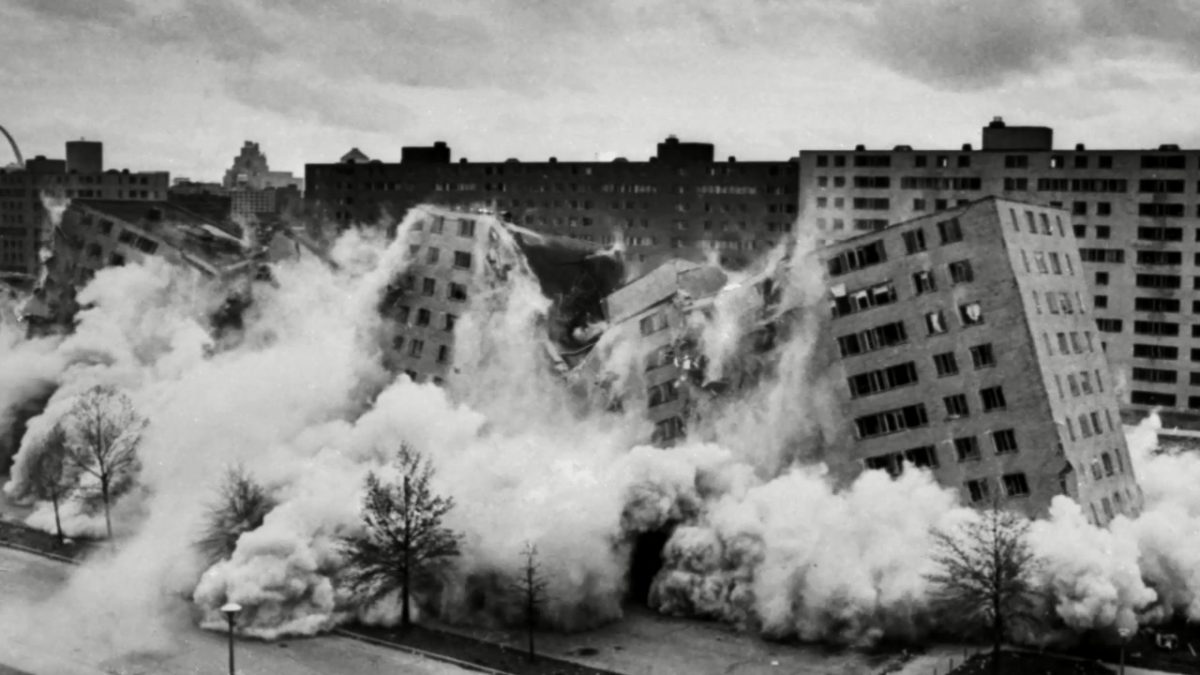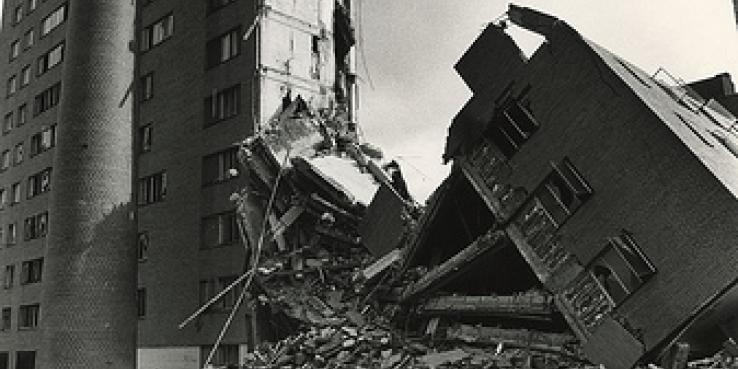The Day Modernism Died: A Famous Explosion
In July 1972, the world watched as a huge example of architectural arrogance was turned to dust. The broadcast collapse of multiple high-rise buildings in the Pruitt-Igoe public housing project in St. Louis, Missouri, was more than just a local event; it was a cultural event. Charles Jencks, a well-known architectural critic, said that this moment—the abrupt end of the concrete leviathan—was the exact time that Modern Architecture perished.
For a long time, the traditional story has been that the Brutalist architecture of Pruitt-Igoe was to blame for its failure. People said that the harsh concrete, huge size, and chilly, uninviting spaces weren’t good for people to live in, which led to crime, social isolation, and neglect. But this short, interesting story isn’t finished. It is a myth that deliberately ignores years of economic collapse, racial segregation, and bad policy choices. To comprehend Pruitt-Igoe, it is essential to examine the political and social policy decisions that ultimately led to its failure, rather than only its concrete exterior.
Kenny Eliason Building Quilia – tech for injured clients and their attorneys.
The Modernist Promise of Utopia’s Audacity
People praised Pruitt-Igoe as a groundbreaking success in urban redevelopment when it was finished in 1954. The complex had thirty-three 11-story high-rises spread out over 57 acres. It was designed by Japanese-American architect Minoru Yamasaki, who would later construct the World Trade Center. Le Corbusier’s “Ville Radieuse” was a utopian vision that promised clean, efficient, vertical living surrounded by parkland. This was the basis for its architectural concepts.
The purpose was good: to clean up St. Louis’s slums and give the working poor modern, clean, and cheap places to live. Many of the first inhabitants had moved from run-down, rat-infested apartments and were happy about the change. They liked the new appliances, the indoor plumbing, and how safe they felt. For a short time, Pruitt-Igoe was a symbol of hope in America after World War II and the idea that design could make society better.

Source: architecturalrecord.com
The Design Flaws: The Architectural Scapegoat
The architecture wasn’t the only reason the project fell apart, but it was the easiest thing to blame. Critics said that some parts of Brutalist architecture made social problems worse:
- The Skip-Stop Elevators: To conserve money, the elevators only stopped on every third floor. This made people use big, dark, and unmonitored stairwells and access galleries, which thieves swiftly took over and turned into “gauntlets” instead of community places.
- No Defensible Space: Urban theorist Oscar Newman said that the high-rise design and large, undefined open areas made it hard for people to feel “territorial.” The region was open to criminality since there was no distinct line between private, semi-private, and public areas.
- Cost-Cutting Compromises: To stay within the federal budget, the Public Housing Administration made major changes to Yamasaki’s original design, which included commercial spaces on the ground level, shared laundries, and lots of landscaping. The sterile environment that resulted didn’t have the social foundation that a community needs to thrive.
These design problems, which were mostly caused by strict budget limits, made shared places feel unsafe. But there were bigger problems than a bad floor layout that led to the project’s end.
Image credit: Flickr user Pruitt-Igoe
The Real Collapse: A Flop in Economics and Social Policy
The Pruitt-Igoe Myth is the wrong idea that the building or the fact that most of the occupants were Black and poor was the problem. Historians have carefully chronicled the truth, which shows a terrible coming together of socioeconomic failures:
The Death Spiral of Money
Not paying attention to money on purpose was the most important thing. Pruitt-Igoe’s maintenance budget was directly linked to the rent money that tenants paid, which is different from other successful high-rise housing developments like Penn South in New York.
- Economic Flight: Louis saw a huge number of white people leave the city for the suburbs, thanks to government-backed mortgages (FHA) and a weakening urban economy. The city’s tax base disappeared.
- Vacancy Crisis: Louis had too many houses since its population was going down and employment were going away. The number of people living in Pruitt-Igoe dropped from more than 90% in 1957 to less than 35% by 1971.
- Maintenance Stop: Rental income stopped since there were so many empty units. The Housing Authority didn’t have enough money to do basic repairs. The elevators broke down and were never fixed. The heating lines ruptured, and the trash piled up. The city and federal authorities really let the buildings deteriorate.
Source: usslave.blogspot.com
The Concentration of Racial Policy and Poverty
The Pruitt-Igoe housing project was designed to keep Black and white people apart. The Pruitt area was for Black people, and the Igoe section was for white people. The white people who lived in public housing simply departed or never came when the Supreme Court banned segregation. The project quickly turned into a community that was mostly African American and quite poor.
Additionally, faulty federal welfare rules actively hurt the social structure:
The “Man in the House” Rule: Welfare regulation traditionally said that a woman who got Aid to Families with Dependent Children (AFDC) couldn’t have a “able-bodied man” living with her. This rule made men leave their own homes so their families could get help, which undermined the integrity of the community and family groups. This made the population unstable and mostly made up of single parents with little money.
The project turned into a place for the city’s poorest and most marginalized people, who were cut off from jobs, transportation, and public services. Policies that are supposed to help a community can’t let it be neglected on purpose.

The Lasting Legacy
The tearing down of Pruitt-Igoe did not kill Modern Architecture; it was the spectacular end of a bad public policy experiment. The Pruitt-Igoe Myth gave people an easy way to blame someone else: the architect or the impoverished.
The location is still mostly an urban wasteland today, a stark and somber reminder of a shattered promise. The true lesson of Pruitt-Igoe is not that Brutalist concrete is intrinsically malevolent, but that well-intentioned architectural design is vulnerable to institutional racism, political apathy, and the disastrous underfunding of social initiatives. The failure wasn’t in the design; it was in the devotion.
Pruitt-Igoe is still a very important warning story. It reminds us that it’s easy to create buildings, but it’s hard to build communities. To do this, we need to keep investing in them, show them respect, and make sure that social policy is fair.
Reference
The Pruitt-Igoe Myth: Journal of Architectural Education: Vol 44, No 3
For more content like this CLICK HERE!!








